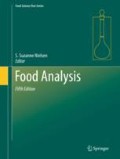Abstract
This chapter provides an introduction to the craft of food forensic investigation, which is described as a logical process for the investigation of root causes for a product that is perceived to be physically objectionable to a customer or consumer because it may have an off-odor/taint, have been contaminated by foreign material during processing or at some later time, or have been intentionally tampered with by an outside party. Products under these circumstances must be analyzed from a perspective different than simply understanding the quality or composition of a product. Food forensic tools and experienced personnel are critical to determine the root cause of both product failures and food tampering. When a product is reported with a problem, it is important to follow codified standard operation procedures to analyze the product to identify what the problem is, where and when it occurred in the supply chain, and how it occurred, so corrective action can be taken. Various specialized nondestructive and destructive techniques (e.g., microscopy, chemical spectroscopy/spectrometry, x-ray microtomography, x-ray diffraction, microchemistry) are critical to investigate such problems of foreign matter contamination. Sensitive instrumental techniques and simple sensory evaluation are critical to identify contaminants causing off-flavors/off-odors and taints. This chapter on food forensic investigations is intended to complement that of both Chap. 33 on chemical contamination and Chap. 34 on extraneous matter.
Change history
23 July 2019
An error in the production process unfortunately led to publication of the book before incorporating the below corrections. This has now been corrected and approved by the Editor.
References
Edwards MC, Stringer MF (2007) The breakdowns in food group. Observations on patterns in foreign material investigations. Food Control 18:773–82
Hsieh D (2015) Food fraud: a criminal activity implementing preventative measures that increase difficulty in carrying out the crime. Food Qual Safety 2 (2):18–23
U.S. Pharmacopeia: USP’s Food Fraud Database Available from: http://www.usp.org/food-ingredients/food-fraud-database
USP – Food Chemicals Codex, Appendix XVII; Food Fraud Mitigation Guidance. Available from: http://www.usp.org/sites/default/files/usp_pdf/EN/fcc/food-fraud-mitigation-guidance.pdf
United States Food and Drug Administration (Internet). Washington D.C.: Food Safety Modernization Act. Available from: http://www.fda.gov/Food/GuidanceRegulation/FSMA/
Canadian Food Agency (Internet). Quebec: Safe Food for Canadians Act. Available from: http://www.inspection.gc.ca/food/
Levy S, Bergman P, Frank A (1999) Quality assurance in forensic evidence. Accredited Quality Assurance 4:253–55
Meek T (2015) Engineering defensibility in food labs. Food Quality and Safety 21 (4):35–37
Pyzdek T, Keller, P. (2013) The Handbook for Quality Management: A Complete Guide to Operational Excellence, 2nd edn, McGraw-Hill Publishers, London, UK
Magnusun ML, Satzger RD, Alcarez A, Brewer J, Fetterolf D, Harper M, Hrynchuk R, McNally MF, Montgomery M., Nottingham E, Peterson J, Rickenbach M, Seidel JL, Wolnik K (2012) Guidelines for the identification of unknown samples for laboratories performing forensic analysis for chemical terrorism. J Forensic Sci 57:636–642
Schwandt CS (2016) Forensic analysis: strategy for identifying contaminants while complying with FSMA. Food Quality and Safety 21 (6):14–5
Li F, Liu Z, Sun T, Ma Y, Ding X (2015) Confocal three-dimensional micro X-ray scatter imaging for non-destructive detecting foreign bodies with low density and low-Z materials in food products. Food Control 54:120–125
Ok G, Kim HJ, Chun HS, Choi SW (2014) Foreign-body detection in dry food using continuous sub-terahertz wave imaging. Food Control 42:284–289
Maire E (2012) X-ray tomography applied to the characterization of highly porous materials. Ann Rev Material Sci 42:163–78
Chen Q, Zhang, C, Zhao J, Ouyang Q (2013) Recent advances in emerging imaging techniques for non-destructive detection of food quality and safety. Trends Anal Chem 52:261–74
Yoon SC, Park B, Lawrence, KC, Windham WR, Heitschmidt GW (2011) Line-scan hyperspectral imaging system for real-time inspection of poultry carcasses with fecal material and ingesta. Comput Electron Agric 79:159–68
Hu S, Liu M, Lin H (2006) A study on detecting pesticide residuals on fruit surface using laser imaging. Acta Agri Univ Jiangxi, Manuscript 013
Mery D, Lillo I, Loebel H, Riffo V, Soto A, Cipriano A, Aguilera JM (2011) Automated fish bone detection using x-ray imaging. J Food Eng 105:485–92
Kilcast D (1996) Sensory evaluation of taints and off-flavours. In: Saxby MJ (Ed) Food Taints and Off-flavors. Chapman and Hall, London, UK, p. 1–40
Reineccius G. (2006) Flavor chemistry and technology. Taylor & Francis, Boca Raton, FL, p. 161–200
Baigrie B (2003) Introduction. In: Baigrie B (Ed) Taints and off-flavours in food, Woodhead, Boca Raton, FL, p.1–4
Saxby MJ (Ed) (1996) Food taints and off-flavors. Chapman and Hall, London, UK
Baigrie B (Ed) (2003) Taints and off-flavours in food. Woodhead, Boca Raton, FL
Marsili R (Ed) (2007) Sensory-directed flavor analysis. Taylor & Francis, Boca Raton, FL
Marsili R (Ed) (1997) Techniques for analyzing food aroma. Marcel Dekker, New York
Acree T, Arn H (2004) Flavornet. Available from: http://www.flavornet.org/flavornet.html
27 Maarse H, Grosch W (1996) Analysis of taints and off-flavours. In: Saxby MJ (Ed) Food taints and off-flavors. Chapman and Hall, London, UK, p. 72–106
Stringer MF, Hall MN (2007) The breakdowns in food group. A generic model of the integrated food supply chain to aid the investigation of food safety breakdowns. Food Control 18:755–65
Acknowledgments
The authors and editor wish to thank the following persons who reviewed this new chapter in the Food Analysis textbook and provided very helpful comments: Baraem Ismail (Univ. Minnesota), Patricia Murphy (Iowa State Univ.), Oscar Pike (Brigham Young Univ.), Tom Vennard (Covance), and Jill Webb (Cairngorm Scientific Services), and all students in the Spring 2016 Food Analysis class at Purdue University. We also want to thank Var St. Jeor for the photomicrographs.
Author information
Authors and Affiliations
Corresponding author
Editor information
Editors and Affiliations
Rights and permissions
Copyright information
© 2017 Springer International Publishing
About this chapter
Cite this chapter
Aimutis, W.R., Mortenson, M.A. (2017). Food Forensic Investigation. In: Nielsen, S.S. (eds) Food Analysis. Food Science Text Series. Springer, Cham. https://doi.org/10.1007/978-3-319-45776-5_35
Download citation
DOI: https://doi.org/10.1007/978-3-319-45776-5_35
Published:
Publisher Name: Springer, Cham
Print ISBN: 978-3-319-45774-1
Online ISBN: 978-3-319-45776-5
eBook Packages: Chemistry and Materials ScienceChemistry and Material Science (R0)

